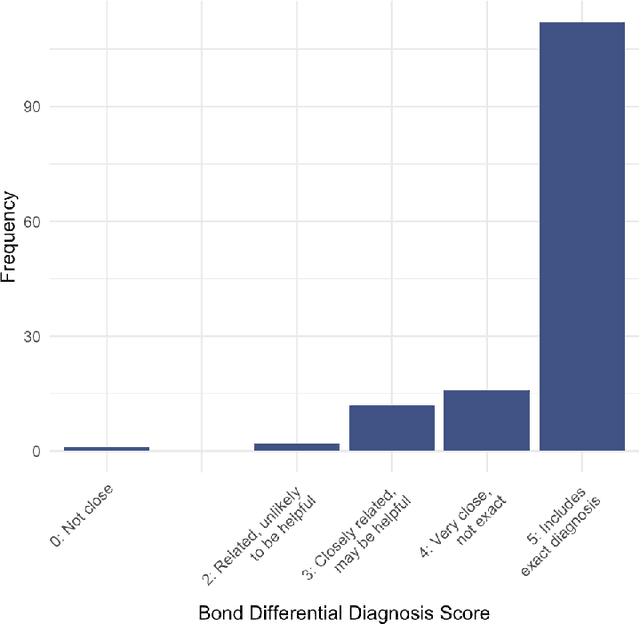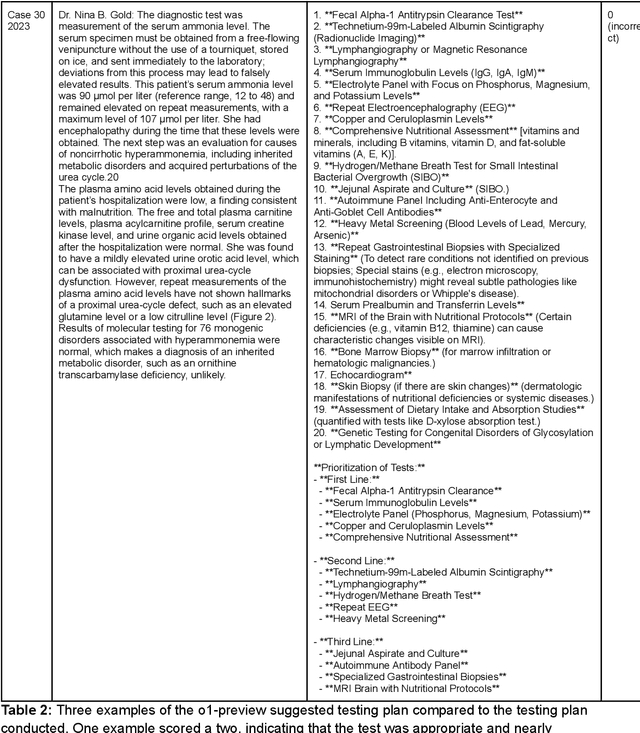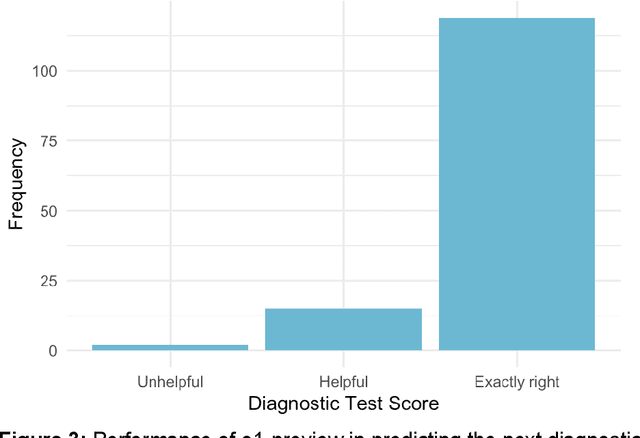Adam Rodman
Towards Conversational AI for Disease Management
Mar 08, 2025Abstract:While large language models (LLMs) have shown promise in diagnostic dialogue, their capabilities for effective management reasoning - including disease progression, therapeutic response, and safe medication prescription - remain under-explored. We advance the previously demonstrated diagnostic capabilities of the Articulate Medical Intelligence Explorer (AMIE) through a new LLM-based agentic system optimised for clinical management and dialogue, incorporating reasoning over the evolution of disease and multiple patient visit encounters, response to therapy, and professional competence in medication prescription. To ground its reasoning in authoritative clinical knowledge, AMIE leverages Gemini's long-context capabilities, combining in-context retrieval with structured reasoning to align its output with relevant and up-to-date clinical practice guidelines and drug formularies. In a randomized, blinded virtual Objective Structured Clinical Examination (OSCE) study, AMIE was compared to 21 primary care physicians (PCPs) across 100 multi-visit case scenarios designed to reflect UK NICE Guidance and BMJ Best Practice guidelines. AMIE was non-inferior to PCPs in management reasoning as assessed by specialist physicians and scored better in both preciseness of treatments and investigations, and in its alignment with and grounding of management plans in clinical guidelines. To benchmark medication reasoning, we developed RxQA, a multiple-choice question benchmark derived from two national drug formularies (US, UK) and validated by board-certified pharmacists. While AMIE and PCPs both benefited from the ability to access external drug information, AMIE outperformed PCPs on higher difficulty questions. While further research would be needed before real-world translation, AMIE's strong performance across evaluations marks a significant step towards conversational AI as a tool in disease management.
Superhuman performance of a large language model on the reasoning tasks of a physician
Dec 14, 2024



Abstract:Performance of large language models (LLMs) on medical tasks has traditionally been evaluated using multiple choice question benchmarks. However, such benchmarks are highly constrained, saturated with repeated impressive performance by LLMs, and have an unclear relationship to performance in real clinical scenarios. Clinical reasoning, the process by which physicians employ critical thinking to gather and synthesize clinical data to diagnose and manage medical problems, remains an attractive benchmark for model performance. Prior LLMs have shown promise in outperforming clinicians in routine and complex diagnostic scenarios. We sought to evaluate OpenAI's o1-preview model, a model developed to increase run-time via chain of thought processes prior to generating a response. We characterize the performance of o1-preview with five experiments including differential diagnosis generation, display of diagnostic reasoning, triage differential diagnosis, probabilistic reasoning, and management reasoning, adjudicated by physician experts with validated psychometrics. Our primary outcome was comparison of the o1-preview output to identical prior experiments that have historical human controls and benchmarks of previous LLMs. Significant improvements were observed with differential diagnosis generation and quality of diagnostic and management reasoning. No improvements were observed with probabilistic reasoning or triage differential diagnosis. This study highlights o1-preview's ability to perform strongly on tasks that require complex critical thinking such as diagnosis and management while its performance on probabilistic reasoning tasks was similar to past models. New robust benchmarks and scalable evaluation of LLM capabilities compared to human physicians are needed along with trials evaluating AI in real clinical settings.
Accuracy of a Vision-Language Model on Challenging Medical Cases
Nov 09, 2023Abstract:Background: General-purpose large language models that utilize both text and images have not been evaluated on a diverse array of challenging medical cases. Methods: Using 934 cases from the NEJM Image Challenge published between 2005 and 2023, we evaluated the accuracy of the recently released Generative Pre-trained Transformer 4 with Vision model (GPT-4V) compared to human respondents overall and stratified by question difficulty, image type, and skin tone. We further conducted a physician evaluation of GPT-4V on 69 NEJM clinicopathological conferences (CPCs). Analyses were conducted for models utilizing text alone, images alone, and both text and images. Results: GPT-4V achieved an overall accuracy of 61% (95% CI, 58 to 64%) compared to 49% (95% CI, 49 to 50%) for humans. GPT-4V outperformed humans at all levels of difficulty and disagreement, skin tones, and image types; the exception was radiographic images, where performance was equivalent between GPT-4V and human respondents. Longer, more informative captions were associated with improved performance for GPT-4V but similar performance for human respondents. GPT-4V included the correct diagnosis in its differential for 80% (95% CI, 68 to 88%) of CPCs when using text alone, compared to 58% (95% CI, 45 to 70%) of CPCs when using both images and text. Conclusions: GPT-4V outperformed human respondents on challenging medical cases and was able to synthesize information from both images and text, but performance deteriorated when images were added to highly informative text. Overall, our results suggest that multimodal AI models may be useful in medical diagnostic reasoning but that their accuracy may depend heavily on context.
 Add to Chrome
Add to Chrome Add to Firefox
Add to Firefox Add to Edge
Add to Edge